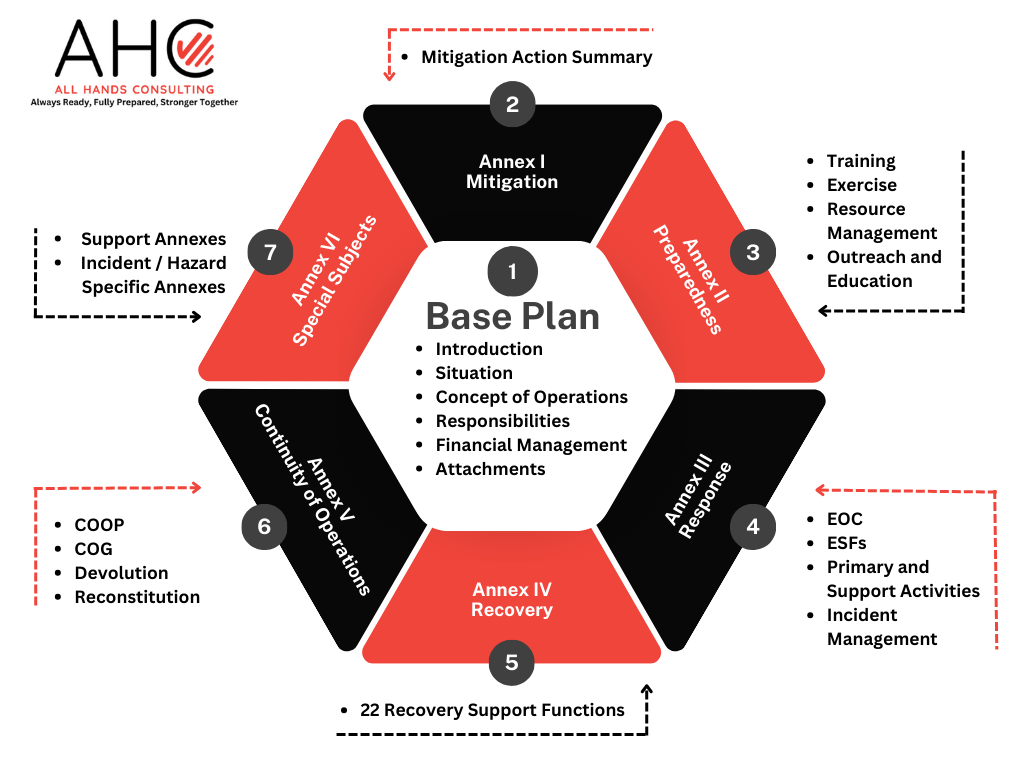Development of a Comprehensive Emergency Management Plan (CEMP) or Emergency Operations Plan (EOP)
NOTE: Our deliverables are compliant with FEMA’s Comprehensive Preparedness Guide (CPG) 101, Developing and Maintaining Emergency Operations Plans, Version 3.
A jurisdiction’s Comprehensive Emergency Management Plan (CEMP) establishes a framework for an effective comprehensive emergency management program. A CEMP describes the basic strategies, assumptions, policies, operational goals and objectives, and mechanisms through which a jurisdiction will mobilize resources and conduct activities to guide and support emergency management efforts through prevention, preparedness, response, recovery, and mitigation. To facilitate effective response and recovery operations, the CEMP adopts a functional approach that groups the types of emergency assistance to be provided into Emergency Support Functions (ESFs) and groups recovery tasks into Recovery Support Functions (RSFs). AHC staff, working for and in close coordination with the jurisdiction’s emergency management staff, will provide administrative, research, planning, publishing services and best practices required to develop a complete CEMP.
Emergency Support Functions (ESFs)
The schedule of ESFs should encompass all of the emergency functions and tasks that will need to be performed by the community during disaster. A singular ESF (often in an annex) analyzes a particular emergency function. The ESF is concerned with that emergency function and specifies the specific tasks to be done, who will do the tasks and if more than one agency/organization is involved, then how they will work together.
In our view, “‘form follows function” in the sense that operational needs should help determine the CEMP or EOP format a jurisdiction uses. The planning team may modify any of these formats to make the EOP fit the jurisdiction’s emergency management strategy, policy, resources, and capabilities.
All Hands Approach
Emergency Support Functions (ESFs) comprise the response elements of a comprehensive emergency management plan and program. We work with each jurisdiction to ensure that their schedule of ESFs works for them. Notional ESF schedule. (Note as per CPG 101 jurisdictions are encouraged to develop an ESF schedule that best works for them).
Emergency Operations Plan (EOP) versus CEMP
- An EOP is a response oriented operations plan (may include recovery).
- A CEMP is a strategic document that is the blueprint for a jurisdiction’s comprehensive emergency management program and as such contains the four phases of emergency management: mitigation, preparedness, response and recovery. An EOP is contained with a CEMP (it is the response element).
A CEMP/EOP Should:
- Serve the needs of a local jurisdiction first (emergencies/disasters are owned at the local jurisdiction level).
- Be all hazards.
- Be the “blueprint” for a jurisdiction’s emergency management program and contain the 4 phases of emergency management.
- “Dovetail” with the next levels of government plans: region, state, federal as per CPG 101:
- “National guidance and consensus standards expect that a jurisdiction’s plans will be coordinated and integrated among all levels of government and will consider critical infrastructure planning efforts. The NIMS and the NRF support a concept of layered operations. They recognize that many operations start at the local level, and, as needs exceed resources and capabilities, State, Regional, and Federal assets are applied. This approach means that planning must be vertically integrated to ensure that all response levels have a common operational focus.”

AHC CEMP PLANNING PROCESS INCLUDES:
1. Obtain background information.
- Review existing plan(s), procedures, and relevant written materials and agree on which portions of the existing plan(s) are relevant.
- Review, research legal planning requirements and basis.
- Review all relevant laws, policies, guidelines to ensure plan compatibility and compliance.
- Determine relevance of state planning guidance.
2. Analyze current situation.
- Gain an understanding of how the jurisdiction is organized, and how it intends to function during emergency and disaster conditions.
3. Identification of hazards.
- Obtain existing community Hazard Vulnerability Assessment (HVA) to obtain knowledge of hazards facing the community. Summarize this information for inclusion in the Basic Plan.
- Determine and agree on best approach to integrate specific hazards concerns, i.e. schedule of special subjects appended to CEMP.
- Summarize mitigation data contained in the HVA (and from other sources) into CEMP Mitigation Section.
- Suggest mitigation strategies.
4. Determine City’s “Concept of Operations” to include:
- Use of ICS and EOC (ICS/EOC interface).
- Relationship of jurisdiction’s emergency management program to higher levels of government, i.e. city to county; county to state..
- What emergency functions are performed by jurisdiction.
- Levels of emergency.
5. Determine CEMP structure, format, content.
- Present, review examples of “best practices.”
- Develop CEMP outline (table of contents).
- Establish outline and format of Basic Plan.
- Determine schedule of emergency function annexes or ESFs.
- Establish common outline, format, content for emergency function annexes or ESFs.
- Determine and agree on best approach to including special functions and hazards of local concern.
- Determine which “special subjects” will be appended to CEMP. Develop list.
- Determine schedule of diagrams, charts, maps.
6. Identify planning process participants and development of planning process workbook.
- Determine which jurisdiction departments, agencies, organizations will be involved in the planning process, and exactly how AHC will work with and through jurisdiction’s Emergency Manager in coordinating with same.
- Develop questionnaire/planning process workbook to be distributed to planning process participants.
- Collect questionnaire/planning process workbooks, compile information and data for inclusion into CEMP, Special Subjects Digest, and EOC Manual.
- Establish data collection filing system.
7. Develop an ESF “primary/support” responsibility matrix.
- Identify and list the plan participants (potential resource providers).
- Develop a matrix that will be used to identify and assess participation of the various agencies involved. (CEMP participants listed on one axis, and the schedule of ESFs listed on the other axis.)
- Fill in matrix. For each EFS indicate which agency will have the lead role (primary) and which agencies will be in a supporting role.
8. Design EOC organization chart (basis for the jurisdiction’s incident management system).
- Determine the EOC functions.
- Determine the sections, branches, units, and assign appropriate departments and EFSs to each.
- Summarize and include details in CEMP Basic Plan.
- NOTE: Organizational chart is the table of contents for the EOC Manual.
9. Establish computer protocols, i.e. central control, back-up system, etc.
- Set up files for the various CEMP parts/sections on computer.
10. Begin writing plan. 11. Produce a first draft of the CEMP.
- Determine what information, content is missing.
- Include first draft of charts, diagrams, other display items.
- Submit to jurisdiction’s emergency management staff for comment.
12. Produce a second draft of the CEMP from comments received on first draft and submit to jurisdiction’s emergency management staff for comment. 13. Prepare final draft, making appropriate changes as per comments received from jurisdiction’s emergency management staff for comment.
- Review and suggest changes to final draft.
14. Produce and submit to jurisdiction’s emergency management staff final electronic copies of plan both in “Word” and “PDF”
